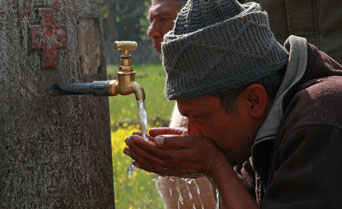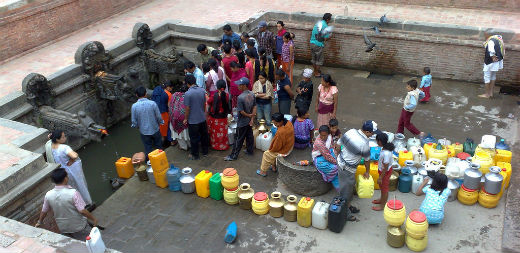By Imran Khan
Dapcha, Nepal–Parvati Adhikari and Sandhya Kumari, washing clothes and filling their ‘gagri’ (water pot) at a tap connected to a natural spring here, are worried over the drying up of the springs — considered a ‘lifeline’ in villages in Nepal’s mid-hills. The consequent spectre of water scarcity is something they never even dreamed of till a few years ago.
“We can’t think of life without springs here as a large number of them are drying up. It is a bad sign for our life in the mid-hills,” said Parvati, resident of Dapcha village in Nepal’s Kavre district, placing a medium-sized ‘gagri’ filled with spring water on her back in a wicker basket to carry home that is situated on a steep slope surrounded by green cover.
 At a time when an acute water shortage across India is making news headlines, drying springs in Nepal’s mid-hills hardly make one take note. But the reality is that water scarcity is a big challenge here — during the dry season at least.
At a time when an acute water shortage across India is making news headlines, drying springs in Nepal’s mid-hills hardly make one take note. But the reality is that water scarcity is a big challenge here — during the dry season at least.
Sandhya pointed out that springs have been providing them water for ages to sustain the needs of households, farms and livestock. “Drying springs is a bad omen for us, as we have relied on springs all our life and are fully dependent on them for livelihood also.”
In fact springs are found all around the hill slopes close to the villages in mid-hills. The springs are fed by groundwater, which accumulates in underground aquifers during the monsoon, effectively turning the hills into water towers.
“The springs that rise in the hills are critical to survival, supplying water for drinking, irrigation and livestock and generally sustaining domestic needs and the rural economy, especially during the long dry season. But many are now drying up, threatening a whole way of life,” said Santosh Nepal, water and climate expert at Kathmandu-based ICIMOD (International Centre for Integrated Mountain Development).
But there is a ray of hope for villagers in Nepal’s mid-hills. Taking serious note of drying springs, ICIMOD, along with its partner Nepal Water Conservation Foundation (NWCF), has started an action research project in 2013 at Dapcha and Tinpiple villages, some 35 km from Kathmandu, to understand this phenomenon and attempt to revive drying springs.
“We are working with the intention of tracking local water processes and finding ways to best use water in order to replenish the drying springs,” said Nilhari Neupane, another expert.
According to researchers, the springs are the lifeblood of the hamlets in Nepal’s mid-hills. Springs can be relatively short lived, providing water for a certain period after the monsoon when the groundwater levels are high or perennial, when they are fed from a level below the dry season water table.
“Our experiments have shown that it is possible to increase the life of springs by increasing recharge rates during the monsoon through the construction of pits and ponds and improving vegetation cover.”
Dipak Gyawali of NWCF said the two-year study found that traditional ponds that existed in the past above the springs played an important role in sustaining the springs below. “It was a result of this that villagers of Darauni Pokhri at Dapcha reported the period of drinking water shortage was reduced significantly after the construction of a recharge pond.”
Loss of springs leads to increased domestic drudgery, with water having to be fetched from more distant sources and increased stress for those whose livelihoods are based on farming. Loss of water can be a significant factor in the outmigration of rural labour and youth from the mid-hills to cities or abroad for permanent or seasonal employment.
The resultant labour shortage in the mid-hills is leading to a sharp decline in food production on the terraced farmlands — a vital national resource built over centuries — and is increasing Nepal’s vulnerability to food insecurity.
Experts point out that springs, which are central to village life, have rarely been properly mapped.
The action research showed that even a small area of a few tens of square kilometres around a hill water tower had over a hundred large and small, seasonal and permanent springs.
Santosh Nepal said the per capita water availability in Nepal is more than 8,000 cubic metres but it is hardly good news for the people living in the mid-hills.
The reason is simple — most of the rivers or streams lie at the bottom of steep mountain slopes and do not provide water needed for sustaining daily life due to prohibitively high cost of carrying by hand pump or pumping uphill.
And in recent years, the local springs, too, have been drying up.
A study conducted by scientists of ICIMOD and NWCF found that the mid-hills are richly endowed with local springs — but as many as 30 percent have dried up in the last decade due to biophysical, technical and socio-economic factors.
After the April 2015 earthquake, most springs in the area yielded less water during the past winter season than in previous years and some have completely dried up.
Although springs are the main water sources in the area, they have been all but neglected in local development plans. The implication of this is far reaching — drying springs reduce agricultural harvests and force outmigration from the villages, Santosh Nepal said.
Navraj Adhikari, local leader at Depcha, said: “After last year’s earthquake, many springs dried up, many became mere trickles. The amount of water of a main local spring in the village has come down.”
Binod Sharma, a water expert at NWCF, said the earthquake that jolted Nepal in April last year had shifted the ground and affected the springs. “Some dried up, while others became more plentiful. We will have to start mapping the springs all over again.”
“Our research showed some major surprises: Nepal’s mid-hills are rich in springs but they are dying. There are approximately five to seven springs per square kilometre but as much as 30 percent have dried up over the past 15 years,” Sharma said.
He said migration of people as a result of chronic lack of water in their villages has accelerated from the hills and mountains.
“The springs that once used to flow profusely have now started to dry up, raising serious concern about the sustainability of water sources in these regions,” Sharma said. (IANS)
















